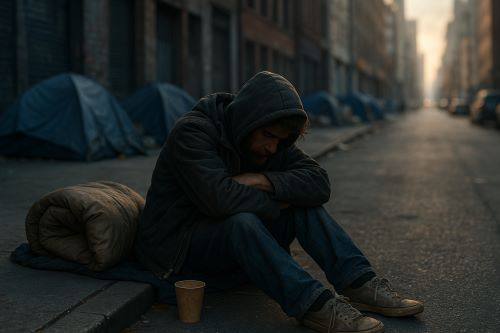

There is an urgent moral dimension to this crisis.

By Matthew A. McIntosh
Public Historian
Brewminate
Homelessness in the United States has reached a staggering and historic high. According to the latest federal data, on a single winter night in January 2024, more than 771,000 people were experiencing homelessness—an increase of 18 percent over the previous year and the highest single-year rise ever recorded. That means roughly 23 out of every 10,000 Americans had no stable place to sleep, the most since the U.S. Department of Housing and Urban Development began tracking such numbers in 2007.
The numbers are not just high—they’re accelerating. In just two years, from 2022 to 2024, the rate of homelessness per capita rose nearly 30 percent, from 1.75 to 2.3 per 1,000 people. This crisis is not confined to any one group or geography. It is affecting families, children, individuals, and the chronically unhoused across rural and urban regions alike.
Families are among the fastest-growing segments of this crisis. Between 2023 and 2024, the number of homeless families with children surged by 39 percent. Approximately 259,000 people—parents and children—now live in temporary shelters, cars, or on the streets. The number of children under 18 experiencing homelessness rose by 33 percent during that same period, approaching 150,000. This is not merely a housing issue; it is a generational emergency with profound implications for child development, education, and public health.
Chronically homeless individuals—those who have been without stable housing for long periods or repeatedly cycle through homelessness—also reached record highs in 2024. While nearly every demographic saw increases, one notable exception was veterans. Veteran homelessness declined by 7 to 8 percent over the past year, thanks to targeted programs combining housing assistance with social services. This success suggests that focused, well-funded intervention can work—if it is applied at scale.
Homelessness among women has also risen steadily, increasing by about 12 percent since 2022. Many are survivors of domestic violence, and for them, homelessness is not just about poverty or rent—it’s about fleeing danger. Women now make up nearly 38 percent of the homeless population. LGBTQ+ youth, too, face disproportionately high rates of homelessness, often due to family rejection or systemic discrimination. Black, Hispanic, and Native Hawaiian/Pacific Islander communities continue to be overrepresented, reflecting the enduring structural racism woven into housing access and economic opportunity.
The causes of this crisis are deeply rooted in economic and policy failures. The most immediate and glaring is the lack of affordable housing. Rents have risen dramatically in recent years, far outpacing wage growth. According to the National Low Income Housing Coalition, there is no U.S. state where a full-time minimum-wage worker can afford a modest two-bedroom apartment at fair market rent. The shortfall of affordable and available rental units for the lowest-income renters is well over 7 million.
Compounding this is the expiration of key pandemic-era protections. Emergency rental assistance, enhanced child tax credits, eviction moratoriums, and expanded food and unemployment benefits offered temporary lifelines. But as those programs were dismantled in 2022 and 2023, many families were left to face inflation, stagnant wages, and rising housing costs without a safety net.
Natural disasters, migration pressures, and mental health challenges have further stressed an already fragile system. In major cities like New York and Los Angeles, an influx of asylum seekers has overwhelmed local shelter systems. Climate-related disasters, such as wildfires in Maui and floods in the Southeast, have displaced thousands. At the same time, drug addiction, untreated mental illness, and inadequate healthcare access remain persistent drivers of chronic homelessness.
Recent legal developments have complicated matters further. In June 2024, the U.S. Supreme Court ruled in City of Grants Pass v. Johnson that municipalities can enforce bans on public camping, even when no shelter beds are available. This decision effectively legalized the criminalization of homelessness, empowering cities to issue citations, fines, or jail time for unsheltered people simply trying to sleep. It has led to a surge in so-called “encampment sweeps” across the country, displacing homeless individuals from one block or park to another without offering real solutions.
The human cost of these policies is profound. People living on the streets face increased exposure to extreme heat, cold, violence, disease, and early death. Hospitals and emergency services are overwhelmed, while public schools struggle to support growing numbers of homeless students. The ripple effects stretch into every corner of civic life—from sanitation to policing to public trust.
Not all responses have failed. Some cities, like Houston, have pioneered a housing-first approach that prioritizes getting people into permanent supportive housing before addressing other issues like employment or addiction. Houston’s model helped drive down veteran homelessness and has attracted national attention. But even in Houston, family homelessness and unsheltered counts are now on the rise again, signaling that such models must be expanded and better funded.
In San Francisco, over $800 million was spent in one year to combat homelessness, yet the city still saw a 7 percent increase in its homeless population. The lesson here is not that funding doesn’t matter—it’s that money must be matched with efficiency, accountability, and scale. Fragmented systems, bureaucratic delays, and lack of coordination between agencies often neutralize even the best-funded efforts.
What’s needed now is a coordinated, national response. This must include massive investment in the construction and preservation of affordable housing. It requires robust eviction prevention programs and better mental health and substance abuse care. Cities and states must be incentivized to adopt housing-first principles, and Congress must restore and expand federal supports that proved so effective during the pandemic. Data-informed models, such as those used in Allegheny County to predict and prevent evictions, should be scaled nationwide.
There is also an urgent moral dimension to this crisis. The United States is the wealthiest nation in human history, yet hundreds of thousands of its citizens are unsheltered, and millions more are on the brink. The problem is not intractable. We have seen what works. We simply have not mustered the will to act comprehensively and compassionately. If the U.S. continues down its current path, homelessness will become a permanent fixture of American life, not an emergency to be solved but a condition to be endured. But it doesn’t have to be this way. The rising tide can be turned—if we choose to see housing not as a commodity, but as a human right.
Originally published by Brewminate, 07.02.2025, under the terms of a Creative Commons Attribution-NonCommercial-NoDerivatives 4.0 International license.


